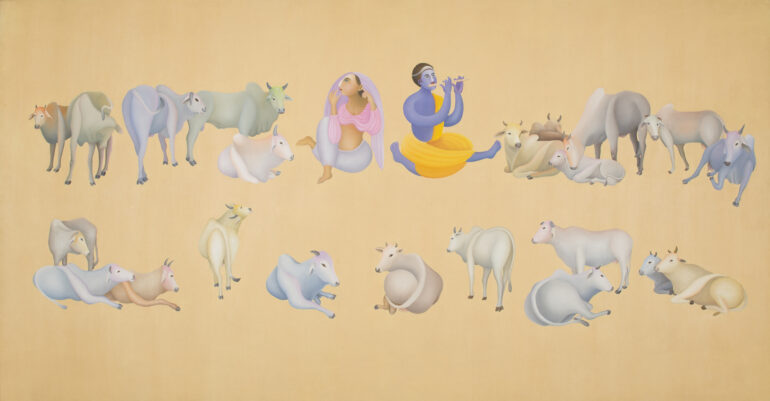The Nita Mukesh Ambani Cultural Centre (NMACC) in Mumbai presents Bhakti: The Art of Krishna, a landmark exhibition curated by Ashvin E. Rajagopalan and exploring universal love and devotion through the life and legacy of Lord Krishna.
Intertwining art and spirituality, the exhibition brings together 107 rarely-seen paintings, sculptures, and historical artifacts – including works by fifteen seminal Indian artists such as Raja Ravi Varma, M. F. Husain, Manjit Bawa, Amit Ambalal, Raqib Shaw, and Thukral & Tagra – in an immersive display that spans 1000 years and diverse cultures.
Bhakti: The Art of Krishna will be on view from July 18 through August 18, 2024, at Art House, NMACC.
Krishna, considered the eighth incarnation of the principal Hindu deity Vishnu and the source of everything, is one of the most popular Hindu gods—a god of love, compassion, and protection. He is a central character in many sacred texts, including the Mahabharata with the Bhagavad Gita and the Puranas, two of the most revered Hindu scriptures, and is depicted in various ways through Indian art, from child to divine lover, to teacher, to hero.
“We are delighted to welcome visitors from near and far into the Art House for this one-of-a-kind exhibition that captures love in all its manifestations. All four floors of the Art House are activated with artworks infused with spirit and devotion, capturing pivotal moments in Lord Krishna’s life, and exploring their larger philosophical significance. This exhibition offers a unique opportunity to engage with the best of Indian art and culture while taking time for self-reflection.” Isha Ambani
Combining art with elements of culture, religion, literature, and sacred geography, this exhibition highlights the essence of bhakti—love for all manifestations of life by recognising Krishna’s presence in them. Artists use the power of image-making to evoke Krishna’s presence and promote ideals of dharma and compassion, offering a moment of personal introspection and celebration of love that transcends religions.
The exhibition narrates the story of Krishna and humanity’s relationship with Him, from Krishna’s birth, and childhood in Gokul, to adulthood, and through his transcendental teachings. His many avatars (facets) are seen and felt in works throughout the show—including Krishna as baby, lover of gopis (cowherd women), leader of the Yadavas, and the teacher to his cousin Arjuna and all humanity through the Mahabharata and the teachings of the Bhagavad Gita, and much more. Painting and object highlights include an 1890 work by Raja Ravi Varma, The Birth of Krishna, exhibited for the first time outside the Fateh Singh Museum in 25 years; two large-scale paintings depicting the love between Krishna and Radha by influential modernist Manjit Bawa; an opulent and detailed contemporary painting by Raqib Shaw; and a four-piece P. Orr & Sons Swami Pattern Silver Tea Set from mid-19th century India, formerly in the collection of Sotirio Bulgari in Rome, depicting the chariot festival in Puri.
Bhakti: The Art of Krishna also features multimedia, immersive experiences—a shadowplay room that addresses issues of confusion and dilemma through shadow forms, a typography room that offers wisdom from the Bhagavad Gita, and a digital projection of Vishwarupa, the all-encompassing cosmic reality of Krishna. Krishna’s teachings of “think good, speak good, and do good” are expressed and felt in these spaces, offering a chance to turn inward and find clarity.
Unique to this exhibition is the opportunity to experience nine different shrines to important temples for Lord Krishna across various regions in India. The shrines represent manifestations of Krishna including Rajagopalaswamy, Guruvayurappan, Udipi Krishna, Hampi Balakrishna, Dwarakadish, Srinathji, Puri Jaganath, Mathura Nath, and Srirangam. While drawing broadly from pan-regional narratives, these different paths of devotion were influenced by the terrain from which they emerged. Having these different manifestations of Krishna helped devotees form personal relationships with Him, seeing Him as a friend, a lover, a child, and a master.

A celebration of Indian culture, heritage, and civilization, Bhakti: The Art of Krishna exemplifies the universality of love and continues NMACC’s commitment to bringing the best of India to the world. The exhibition offers a break from life’s chaos, a moment to learn, reflect, and engage with Bhakti.
The Nita Mukesh Ambani Cultural Centre is a first-of-its-kind, multi-disciplinary space in the sphere of arts, within the Jio World Centre, located in Mumbai’s Bandra Kurla Complex. The Cultural Centre is home to three performing arts spaces: the majestic 2,000-seater Grand Theatre, the technologically advanced 250-seater Studio Theatre, and the dynamic 125-seater Cube. The Cultural Centre also features the Art House, a four-storey dedicated visual arts space built as per global museum standards with the aim of housing an array of exhibits and installations from the finest artistic talent across India and the world.
Spread across its concourses is a captivating mix of public art by renowned Indian and global artists, including ‘Kamal Kunj’ – one of the largest Pichwai paintings in India.
Bhakti: The Art of Krishna is at The Nita Mukesh Ambani Cultural Centre in Mumbai, India, from 18th July until 18th August, 2024.



